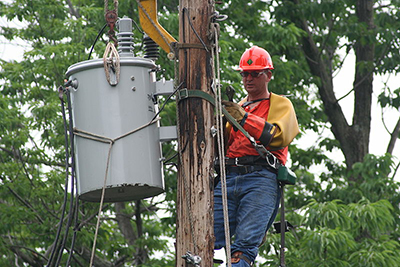In the previous sections, you looked at how a current can induce a magnetic field in space; a magnetic field can induce a current in a wire; and the wires in a magnetic field can react to a force. These three pieces work together to make the larger concept of magnetic induction. The three most common uses for magnetic induction are generators, motors, and transformers.
In this section, you will further investigate and describe the relationship between electric and magnetic fields in applications such as generators, motors, and transformers.
Let’s start by looking at motors and generators.
![]() Take a moment to watch the quick video introduction below. As you watch the video, complete the following tasks (note: you may wish to pause the video, or watch it more than once to complete your answer).
Take a moment to watch the quick video introduction below. As you watch the video, complete the following tasks (note: you may wish to pause the video, or watch it more than once to complete your answer).
Briefly describe a generator.
Briefly describe a motor.
What is the relationship between electric and magnetic fields seen in generators and motors?
Magnetism: Motors and Generators, CHMnanoed, YouTube
Most of the electricity generated in the United States requires the use of a generator. A generator is a machine that uses magnetic induction to turn mechanical energy into electrical energy by either moving wires through a magnetic field or moving a magnet through a coil of wires. The force required to create the motion is either provided directly by wind or moving water or by steam from water heated by burning fossil fuels or a controlled nuclear reaction. No matter how the mechanical energy is obtained, the basic generation of the electricity is the same. The following is a simplified version of an electric generator.
Click on the link below to download and run the application. It will open three different windows, in the Generator window click on “show graph” in the bottom right hand corner. Observe the Generator and the Data Plot.
An electric motor works on the exact same principle, except that we now supply electrical energy, and the output of the motor is mechanical energy.
Click the link below to open the interactive exercise. Before the motor will start, check to make sure the red and black cables are connected and the boxes in the lower left hand corner are checked. The voltage can be adjusted on the Voltage Generator. Click the on button on the PCCL to observe the motor.

Source: Lineman changing transformer, Dave Pape. Wikimedia Commons
![]() Take a moment to think about how many different types of electronic equipment you use every day. Do you think each piece of equipment will use the same amount of electricity? For example, does a microwave use the same amount of electricity as a refrigerator?
Take a moment to think about how many different types of electronic equipment you use every day. Do you think each piece of equipment will use the same amount of electricity? For example, does a microwave use the same amount of electricity as a refrigerator?
Of course, you know that a microwave does not use the same amount of electricity as a refrigerator, but how does each piece of electronic equipment get the amount of electrical current it needs to run properly without getting too much or too little?
Movement of electricity from the point of generation to the use in everyday life requires the use of a special type of device called a “transformer.” A transformer is an apparatus that reduces or increases the amount of the voltage being received from an alternating current (like the one seen in the picture above).
How does a transformer use the relationship between electric and magnetic fields to work?

How Transformers Work, t33chin, YouTube